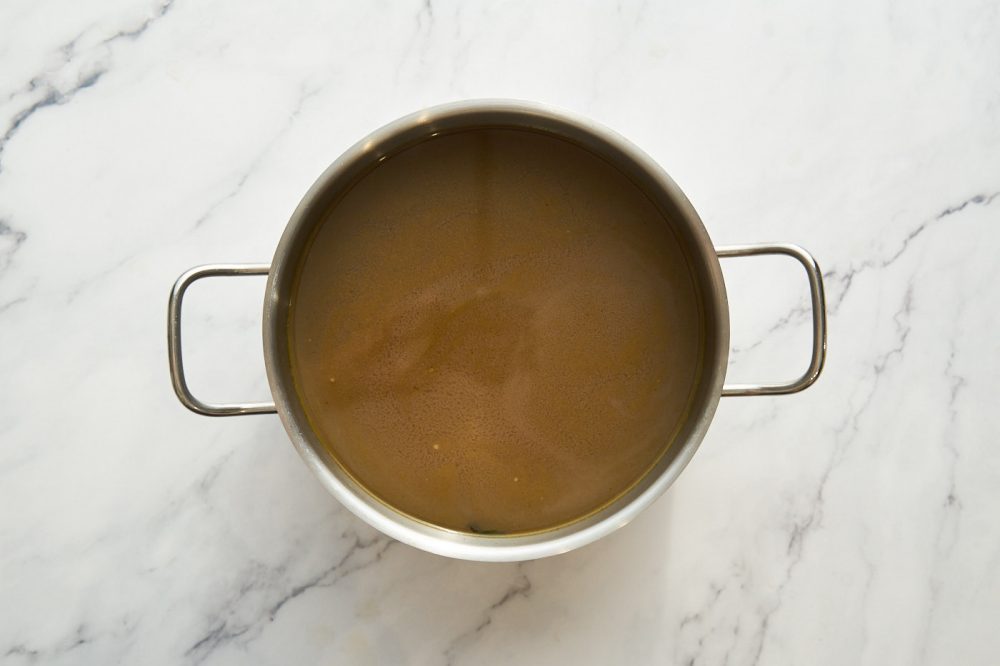Also known as lobster stock or lobster bouillon, lobster base is a concentrated paste used to add depth and flavor to a variety of dishes, from soups to stews and sauces. However, sometimes, it may not be readily available or fit dietary needs. Whether you’re unable to access lobster base, allergic to shellfish, or catering for a vegetarian or vegan guest, there are various substitutes you can use. Clam juice and fish stock are excellent alternatives for seafood-based dishes, while vegetable broth or stock could be a good option for those seeking plant-based alternatives.
👅 Flavor Profile
Lobster base is known for its rich, savory, and distinctly seafood flavor. It carries the essence of lobster with a slightly sweet and briny undertone, adding complexity to any dish. Its flavor is quite concentrated, and it imparts a deep seafood essence that is unique to lobster. It’s also salty, so chefs often use it sparingly to prevent overpowering other ingredients. The texture is usually a thick paste that easily dissolves in liquids, making it perfect for soups, stews, and sauces.
🔄 The Closest Replacements/Substitutes
Clam Juice
Clam juice is a fantastic alternative that still gives a profound seafood flavor to your dishes. It’s less sweet compared to lobster base but carries a beautiful salty and briny flavor that pairs well with many recipes. When using clam juice, you can use it in equal amounts as the lobster base in your recipe. However, consider reducing any additional salt since it’s already quite salty.
Taste and Texture: Clam juice has a briny, savory flavor with a thin texture.
Nutritional Comparison: Clam juice is low in fat and calories and contains some essential minerals like zinc, but it has less protein than lobster base.
Price and Availability: Clam juice is generally more affordable and widely available in supermarkets.
Fish Stock
Fish stock is another excellent substitute, particularly for soups, stews, and sauces. It delivers a delicate seafood flavor, though less pronounced than lobster base. To use fish stock as a substitute, you can swap it out equally for lobster base. If you want a stronger flavor, consider reducing the stock to concentrate it.
Taste and Texture: Fish stock has a mild, savory seafood flavor with a liquid texture.
Nutritional Comparison: Fish stock is low in calories, fat, and contains beneficial nutrients, but the exact amount varies based on the types of fish used.
Price and Availability: Fish stock is relatively easy to find in most grocery stores, and you can also make it at home using fish bones.
Vegetable Bouillon
Vegetable bouillon could be a potential substitute for lobster base, particularly for vegetarians and vegans. While it lacks the unique seafood flavor of lobster base, it can still provide a savory depth to your dishes. Use the same amount of vegetable bouillon as you would lobster base.
Taste and Texture: Vegetable bouillon is savory and slightly sweet, with a texture that varies depending on whether it’s in cube or powder form.
Nutritional Comparison: Vegetable bouillon can contain a high amount of sodium but is generally low in fat and calories. It also lacks the protein found in lobster base.
Price and Availability: Vegetable bouillon is widely available in supermarkets and is generally quite affordable.

Crab Stock
Crab stock can be a good replacement if lobster base isn’t available. It has a similar seafood flavor but tends to be a bit sweeter. Use crab stock in equal amounts as lobster base in your recipe.
Taste and Texture: Crab stock is sweet and full of sea flavor. The texture is liquid.
Nutritional Comparison: Crab stock is low in fat and contains some minerals and proteins, although not as high as lobster base.
Price and Availability: Crab stock can be a bit harder to find than other alternatives and might be a bit more expensive.
Chicken Bouillon
While chicken bouillon doesn’t have the seafood flavor of lobster base, it can still add a savory depth to dishes. It’s best used in recipes where the lobster flavor isn’t the star of the dish. Use chicken bouillon in the same quantity as lobster base.
Taste and Texture: Chicken bouillon is rich and savory with a slightly salty note. It can come in cube, powder, or liquid form.
Nutritional Comparison: Chicken bouillon can be high in sodium but is generally low in calories and fat. It does contain some protein.
Price and Availability: Chicken bouillon is inexpensive and widely available in most grocery stores.
🔪 How to Use Lobster Base Substitutes in Recipes
Lobster Bisque
Lobster bisque is a classic seafood soup that relies heavily on the flavor of lobster base. When using a substitute, it will be key to supplement with other seafood ingredients and herbs to maintain the richness of flavor.
Seafood Pasta
A seafood pasta can benefit from a replacement lobster base. The base is usually used to season the pasta sauce, so a substitute like fish or vegetable bouillon could add depth to the dish.
Seafood Paella
Seafood paella traditionally uses a variety of seafood, including lobster. A replacement for lobster base in this dish could be a flavorful fish or chicken stock, which would complement the other seafood elements in the dish.
Seafood Gumbo
Seafood gumbo relies on a rich, flavorful base to carry the medley of seafood and spices. A seafood stock or vegetable bouillon could provide a similar depth of flavor when a lobster base is not available.
Seafood Chowder
Seafood chowder is another dish that typically uses lobster base for its rich flavor. The use of a fish stock or crab stock could maintain the hearty, seafood-forward flavor of the chowder.
Lobster Thermidor
In this classic French dish, a rich and creamy sauce often includes lobster base for an intense seafood flavor. A strong fish stock could make a good replacement in this dish.
💡 Tips and Guidance
When it comes to substituting lobster base in your favorite dishes, here are some tips and guidelines to help you out:
- Quantity: The quantity of the substitute can vary depending on its intensity. For example, if you’re using fish stock or vegetable bouillon, you might need to use more than you would if you were using lobster base. Start with a small amount and increase it gradually until you reach the desired taste.
- Complement with Additional Seafood: If you’re using a less seafood-oriented substitute, consider adding other seafood ingredients to the dish to ensure the seafood flavor remains prominent. This could be shrimp, clams, mussels, or even a small amount of lobster meat if available.
- Enhance Flavor with Herbs and Spices: To elevate the flavors of your substitutes, consider incorporating additional herbs and spices. For example, ingredients like bay leaves, thyme, and paprika can greatly enhance the flavor of a seafood dish.
- Adjust Cooking Times: Remember that different substitutes may require different cooking times. For example, while a lobster base can be added at any time, fresh ingredients like seafood or vegetable stock may need more time to simmer and release their flavors.
- Experiment with Different Combinations: Feel free to experiment with different combinations of substitutes. You might find that a mix of vegetable bouillon and clam juice creates a unique flavor profile that works well for your dish.
- Keep Nutritional Balance in Mind: While flavor is important, also remember to consider the nutritional content of your substitutes. If you’re substituting for dietary reasons, make sure your alternative aligns with your nutritional needs.
Remember, the aim is to inspire creativity in the kitchen. Experimenting with different substitutes not only helps in situations when you don’t have certain ingredients, but also enables you to discover new and exciting flavors. So, next time you find yourself without lobster base, don’t panic – embrace the opportunity to try something different!
